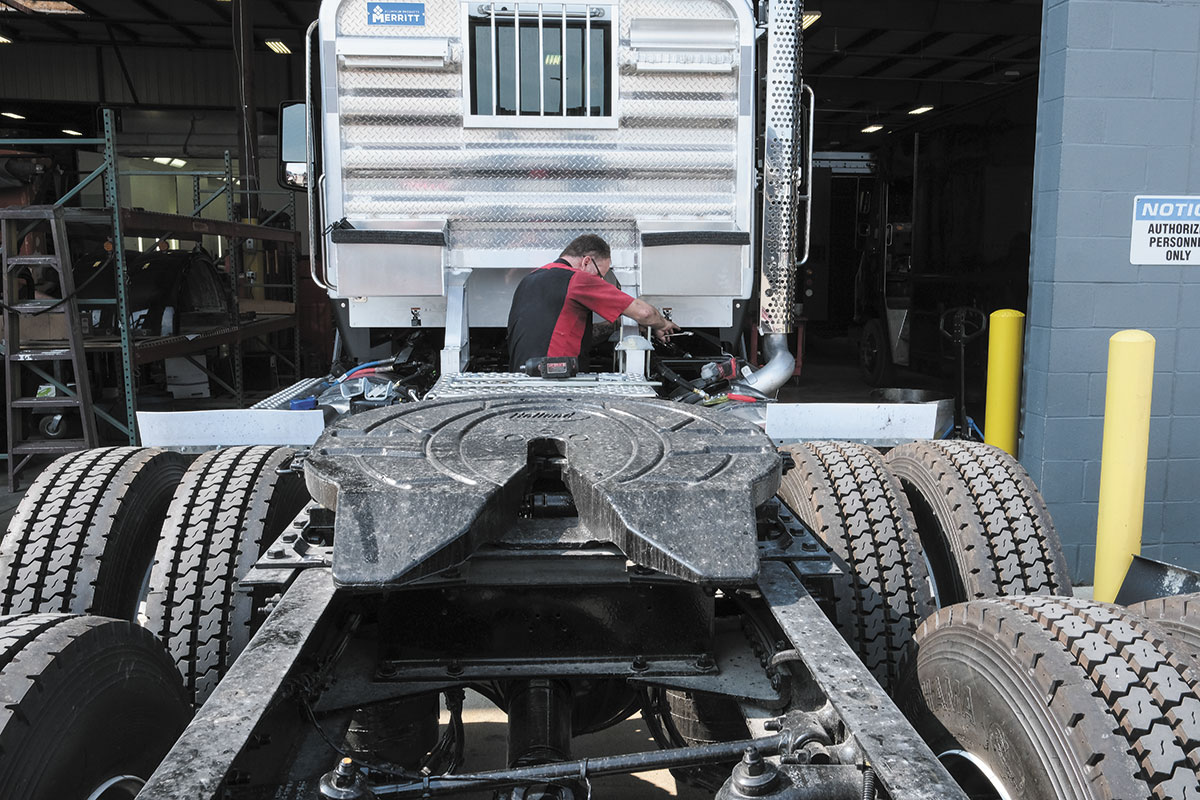Subscriber Benefit
As a subscriber you can listen to articles at work, in the car, or while you work out. Subscribe Now
(IBJ photo/Eric Learned)
The economic effects of the pandemic created boom times for trucking—but the industry has hit an extended bumpy patch since then, with no consensus as to when conditions will smooth out.
Though trucking is by nature a cyclical industry, insiders and industry observers say the current downturn, which began in early 2022, has been uniquely long-lasting and severe.

Gary Langston, president of the Indiana Motor Truck Association, said conditions are the worst he’s seen in the 13 years he’s been with the organization. “This is certainly the most challenging time that’s occurred since I’ve been here,” Langston said. “It’s hit really hard.”
Geoffrey Wilson, a San Francisco-based analyst who covers the trucking industry for S&P Global Ratings, has a similar view.
The trucking industry’s economic cycle—the time from the top of the market to the bottom, and back up again—usually takes about three years, Wilson said. But two years into this slump, there’s no clear sign yet of a rebound.
“Everybody is saying the same thing: ‘This recovery cycle is very abnormal,’” Wilson said. “The scale and duration of this down cycle is unprecedented.”
So what’s going on? As with so many other unusual economic events of the past few years, the roots trace back to the pandemic.
Pandemic-related consumer spending shifts and supply-chain disruptions created intense demand for trucking services, and shipping rates skyrocketed.
“We came out of some of the best times that trucking has ever enjoyed,” Langston said. “Quite frankly, we were on a sugar high like never before.”
The boom times drew more companies into trucking, and in a classic case of supply and demand, that caused shipping rates to fall. Add in inflation and the trucking industry’s long-standing driver shortage, and carriers are now trying to weather a storm.
According to data from DAT Freight and Analytics, average spot rates for dry-van trucking—basic, unrefrigerated semitrucks—topped out at $2.70 per mile in December 2021 and January 2022, about a dollar per mile higher than in December 2019.
Rates have plunged since then and have averaged less than $2 per mile since mid-2022. Rates stood at $1.61 per mile as of May 12, the most recent data available on the U.S. Bureau of Transportation Statistics website.
Typically, Wilson said, an oversupply of trucks eventually corrects itself because the low freight rates push some operators to the sidelines. A self-employed driver with his own truck, for instance, might park that truck for a few months and seek other employment until rates start to climb again. Or a trucking company might go out of business altogether if rates drop too low to cover expenses.
Wilson theorized that this downturn is so persistent partly because the pandemic-fueled highs were so high. Trucking companies made so much money when rates were high that, if they were prudent with their spending, they’ve built a cushion to help ride out the slowdown. “Those with more resources can hold out longer.”

Small firms, big troubles
Jacob Nichols, chief human resources officer and co-president of Indianapolis-based dealership Palmer Trucks, said his company hasn’t seen much of a drop in business. Palmer sells and services new and used semitrucks.
But Nichols said small trucking companies often don’t have a cushion to get them through tight times. For a company that owns just a handful of trucks, the loss of a contract or an unexpected repair bill can spell disaster.
“To take a hit of $30,000 to fix an engine, a small company like that doesn’t have the ability to weather that,” Nichols said.
According to the U.S. Department of Transportation, more than 90% of the nation’s trucking companies operate 10 or fewer trucks.

Indianapolis bankruptcy attorney Mark Zuckerberg said his office never used to get calls from trucking companies. That has changed in the past five or six months, he said; he now gets three or four queries a week. Some callers are just exploring their options, Zuckerberg said, but about one each week does end up filing for bankruptcy protection.
Zuckerberg said most of these callers own small trucking companies that started up shortly before the pandemic and operate four to 10 trucks.
“They say that they did make money in the first couple of years, and now in today’s environment, they’re not able to make any money,” Zuckerberg said. “They’re just not getting paid what they used to get paid per load.”
‘Hard times’
The struggle is reaching up to some large companies, too.

Last August, for instance, one of the nation’s largest trucking companies, Nashville, Tennessee-based Yellow Corp., filed for bankruptcy and shut down, putting 30,000 people out of work.
“It’s hard times right now,” said Jessica Warnke, CEO of Anderson-based Carter Express, which has a fleet of about 900 trucks and 2,500 trailers.
Warnke said her company is somewhat insulated from the swings of the spot freight market, which is negotiated on a per-load basis and thus reflects current market prices. Carter is a contract carrier; its rates are locked in for the duration of the contracts it signs with its customers.
But Warnke said Carter is not immune because some customers try for midterm contract negotiations or might try to break their contracts outright in search of better rates. “Even as contracted carriers, you’re feeling that pressure from your customers.”

Attorney Greg Feary, president and managing partner at Indianapolis-based transportation law firm Scopelitis Garvin Light Hanson & Feary PC, said several other factors are also weighing on trucking companies right now.
Interest rates are higher than they were a few years ago, making it more expensive to finance a truck purchase. Tighter emissions standards are set to go into effect over the next three years, and carriers are also facing an increased number of class action lawsuits, Feary said. One hot area of trucking litigation, he said, involves drivers suing their employers over privacy issues related to biometric data collected by truck technology.
Looking ahead
Feary said he believes the pace of trucking bankruptcies is slowing down and that better times are ahead. “I think the market is correcting itself. We’re hoping that the last half of the year will prove that we’ve hit bottom when it comes to freight levels and freight rates.”
Wilson, the trucking analyst, isn’t so sure. For several quarters now, he said, trucking industry executives have been predicting a market turnaround that has yet to materialize.
During a quarterly financial call with investors in April, executives at one of the country’s largest carriers, Arkansas-based J.B. Hunt Transport Services Inc., underscored that uncertainty.
“If you think about the last four years … the highs and lows have been more dramatic than any time period in my 30-year career,” J.B. Hunt President Shelley Simpson said. “And so our ability to predict has been very difficult. We have seen periods of positives that then quickly fall off.”
Wilson said it could be the end of this year or early next year before conditions start to improve. He’s not confident about that, though.
“If executives at trucking companies can’t put a date on it, I certainly can’t,” he said.•
Please enable JavaScript to view this content.

This industry was eviscerated in 1983. I ‘loved’ Reagan, but using Liz Dole as his union buster did irreparable damage. Deregulation is appropriate for a lot of things but not airlines and trucking.
When is the last time you saw an OPEN weigh/inspection station along the interstate? Ever asked yourself why almost daily there is a flipped over semi on some interstate within 5 miles of downtown? Indiana’s law restricts trucks with at least 10,000 lbs GVW to the far right lane unless exiting or entering a ramp. Never enforced. Since we will never see tollways or ‘truck only’ lanes, all vehicles exceeding 20,000 lbs GVW need to be kept at 50 miles per hour once inside I-465.
The big problem is that the federal gas tax hasn’t scaled with inflation & infrastructure costs since the 1990s. Long haul trucking seems viable over long haul rail (+ short haul ‘last mile’) at face value, but it actually isn’t. Trucking companies pay drivers very little just to stay competitive, all the while we have trucks that use more infrastructure than they pay for. Not to mention the environmental clean up that will eventually be needed by burning so many fossil fuels, but that our gas tax doesn’t even attempt to account for.
If we raised the gas tax such that it could maintain infrastructure (and we pegged it to inflation), rail freight would explode. Instead, we’ve done nothing for 30 years. We’re so deep in the hole that fixing the problem would make for a fast market correction, putting a ton of people out of work before they knew what happened. A lot of people in the trucking industry – and related industries – would’ve gone with another career path had gas taxes kept up with inflation.
A lot of industries across the US appear to be in analogous situations. Started going down the wrong path decades ago due to government inaction & now too far in to fix things cleanly.
A lot of things contributed to COVID-era inflation. The chief contributor was probably the sharp reversion to the mean in the demand for goods that occurred right after the economy shut down & nearly every part of the supply chain lowered or idled its capacity. ‘Growing pains’ inflation…
The trucking industry was right in the middle of this. It should’ve been clear to these companies that the rise in rates was temporary.
In other news, this is a good sign that inflation is finally cooling.